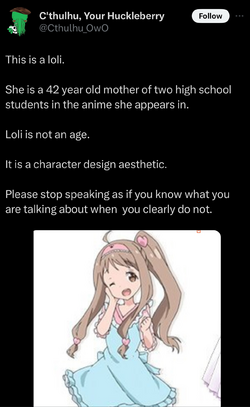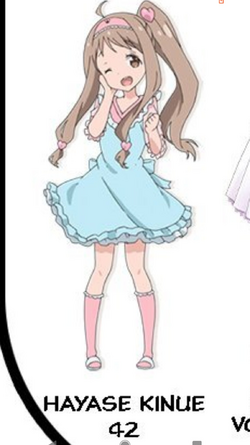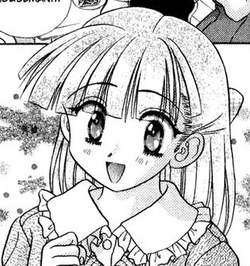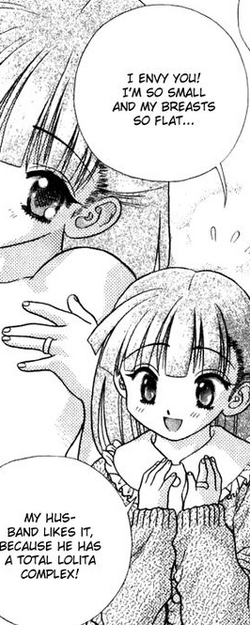
And the
classic “she’s older than she looks” cope.

Oh yeah of course. Looking at her, I totally belive that she had two kids with that 12 year old hip bone…..
I genuinely hate the fact that pedophiles say they like Lolishit for the “aesthetic”.
“Loli aesthetic” doesn’t fucking exist. It’s called “Moe” you fucking degenerates.
A'ight, I think this could be a good point of discussion in determining the difference between "loli aesthetic" (which I agree isn't a thing even with the moé style, but I'll get to it) and "loli for getting your jollies off" characters because
context always matters. I'm more familiar with the former case than the latter simply because the latter is something that comes out of the blue in most cases and are extremely frustrating to deal with, though I do have one example of such at the end simply because it's pretty egregious in the fandom.
So Hayase Kinue there is a character from
Masamune-kun's Revenge. She is the mother of the titular character, and she is indeed stated to be a 42-year-old housewife with a passion for cooking (Masamune used to be a fat kid). Her husband is currently in prison because he got arrested on pedophile charges after being seen walking around with her and their child even though they're legally married and she's of age.
That's the joke.
Konata Izumi ends up turning 18 as you follow her senior year in high school. Since her classmates do graduate at the end of the series, you can determine they may also be 18 by then, but I wonder if it's due to Konata's popularity that we even have her age to begin with. Well anyway, Konata is also the spitting image of her mother,
Kanata, which I believe also includes personality, to the point her friends thought a picture of her mother was of Konata herself. I do not recall lolicon jokes in
Lucky Star, though, that's more of a fandom thing. This is one of many examples of the kind of phenomenon in moé where the mother is younger than she looks, and it's so common it tends to be done to poke fun of itself as shown with
Masamune-kun's Revenge. So it's very much tongue-in-cheek, and you can typically glean this through hints in the series if you're savvy to it.
For an obscure example that's a bit more straightforward:

This here is Shoko Shina, a minor character from the long-running I-can't-believe-it's-not-real-hentai-ecchi manga
Futari Ecchi. She's 24 and married to a giant, and is a smut novelist, but she dresses like a doll.

And her husband is apparently a lolicon which was why they got married and might be why she dresses as such. Yes, you do see at least one sex scene between the two of them, and because of her realistic proportions, the narrator has to consistently chime in "REMEMBER: SHE'S 24!", although artists will notice she somewhat has a pelvic curve and thicker thighs that real children do not have. Still, that's her body type, and it possibly plays into the reason you rarely see her get into sexy situations despite the disclaimers. (That's why it's a bit jarring that in a manga about adults having so much sex you see the main character's younger sister, who's 16, start exploring her sexuality, but 16
is the age of consent in Japan, so...)
Now this here is the more straightforward example for this thread, although I have to put an asterisk here because I have
so many questions about Yuka Mochida's inclusion in the horror game
Corpse Party.
She's a 14-year-old middle schooler, but doesn't look and act her age partly due to her oniichan complex, and partly because it's highly likely the creator is a lolicon himself. At least in this case, you could say she's filling in for an archetype, but it turns out Yuka's main role is to be the little sister who gets targeted by a murderous psycho who might have a little sister complex taken up to eleven. And she is also the main subject in the piss fetish the creator
possibly also has, and yes, it's extremely uncomfortable, made much more worse in the manga and its ecchi spin-off. There's a number of scenes involving her trying to hold it in when she doesn't find an actual toilet and while she's clearly scared to death during every single moment, there's
way too much focus put on it that it might as well be fanservice for the piss fetish lolicons out there. Characters who hang themselves do wet themselves, but they don't get the main focus on it like Yuka does.
The kicker here is that
none of that is present in the original game. She has a moment where she has to go to the bathroom since this is a trope in horror, but then the stall starts to flood with blood because of a malevolent ghost and her brother has to save her. She doesn't need to pee again after that.
This is such a very fine line between being played for horror and being a straightforward loli fetish that I don't know why everything surrounding her had to change from the original game or if this was due to the creator sneaking in his fetish in the remake thinking no one would notice or care. The situation here with Yuka is one out of many in manga and visual novels that unless it's out-right explicit about it being a lolicon series, you just
cannot escape the possibility of coming across it. This right here is the reason why normal anime fans regularly get lumped in with the real lolicons, and
Corpse Party is a niche series to begin with. It's a horror series, but it got upgraded to the guro subgenre (or borderline-guro, the number of pantyshots in
Blood Covered is sus), and so a piss fetish sneaking its way into it wouldn't have been unfeasible.
Of course, it's worth pointing out lolicons do have common overlap with those who have imouto (little sister) complexes and incest fans on top of other fetishes
like piss, so it's just a potpourri of degeneracy at that point.
This is why lolicon is not an aesthetic like the tweet claims because it's a
character type. Anyone who claims otherwise is trying to deflect they have a
type, and their 2-D (maybe 3-D) waifus tend to be of this type. There's a reason "moé" is used when talking about character designs because then
everyone looks like it while it has to be
stated that a character is the loli type. But because lolicons just can't shut the fuck up and stop cooming, and pedophiles aren't being stoned on a daily basis, the non-offending (and sometimes
adult) characters will forever be grouped in with the
marketed lolicon stuff, and this causes innocent huge-guy/tiny-girl dynamic fans to get swept into it.
























